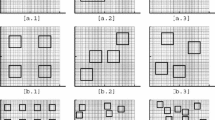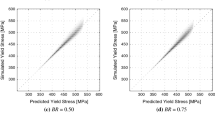Abstract
This work presents a unified approach to predict surface strains at failure in bulk forming processes. The approach does not deal with a specific process but rather with prescribed strain and stress paths. The material to be processed is assumed to possess an initial void volume fraction that grows and colaesces with straining, ending by fracture. The predictions are based on a formulation for voided solids according to the Gurson-Tvergaard yield function adapted to include orthotropic anisotropy. The incident of fracture is characterized by shear band formation within the ligaments of the matrix material among spheroidal voids as described by McClintock. The results are represented by a straight line plot of tensile limit strain versus the compressive strain for different loading paths. These limit curves are shown to be dependent on the initial void fraction, hardening, and anisotropy of the matrix matrial. Alloys with lower initial void fractions as well as those of higher hardening show better workability. The model is applied to predict bulk formability curves for steels AISI 1040 and 1045, Aluminum AI 7075-T6, and copper, based on the proper selection of micromechanical parameters for these alloys. The validity of the model is ensured through fairly favorable comparison with experimentally determined limit curves. The current failure conditions are suitable to predict the experimental dual slope fracture line that may exist for some alloys such as cold-drawn steel AISI 1045 and aluminum 2024-T6 by considering two mechanisms of failure: internal necking in the ligament material between voids, followed by transition to shear band formation.
Similar content being viewed by others
Abbreviations
- b1, b2:
-
length of axis of a spheroidal void and surrounding matrix material, respectively, transverse to maximum principal stress
- f :
-
void volume fraction
- n :
-
strain-hardening exponent
- q1, q2:
-
semiempirical parameters in Gurson-Tvergaard yield function
- R, P :
-
orthotropic anisotropy ratios along and transverse to rolling direction, respectively: R=r 0 and P=r 90
- α :
-
stress ratio: σ 2/σ1
- ρ :
-
strain ratio: ε2/ε1
- ε j :
-
strain components (j=1, 2, 3)
- ɛ,ɛ M :
-
effective macroscopic strain and effective matrix strain, respectively: ɛ=(3 ε bij ε bij /2)1/2
- λ1 :
-
aspect ratio of a spheroidal void
- ω j :
-
stress components (j=1, 2, 3)
- σm :
-
mean stress: σm=σjj/3
- O,O M :
-
effective macroscopic stress and effective matrix stress, respectively
- M:
-
matrix
- i:
-
initial
References
G. Dieter: in ASM Metals Handbook, 9th ed., ASM, Metals Park, OH, 1987, vol. 8, pp. 571–97.
H.A. Kuhn: in Advances in Deformation Processing, J.J. Burke and V. Weiss, eds., Plenum Press, New York, NY, 1978, pp. 159–85.
S. Kobayashi: Trans. ASME, Journal of Engineering for Industry, 1970, vol. 92, pp. 391–99.
P.W. Lee and H.A. Kuhn: Metall. Trans., 1973, vol. 4A, pp. 969–74.
D.C. Shah: in Mechanical Working and Steel Processing, TMSAIME, The Metallurgical Society, New York, 1974, vol. 12, pp. 285–300.
S.I. Oh and S. Kobayashi: Trans. ASME, Journal of Engineering for Industry, 1976, vol. 98, pp. 800–06.
H.A. Kuhn and P.W. Lee: Metall. Trans., 1971, vol. 2A, pp. 3197–202.
P.F. Thomason: International Journal of Mechanical Science, 1969, vol. 11, pp. 187–98.
M.G. Cockroft and D.J. Latham: J. Inst. Metals, 1968, vol. 96, pp. 33–39.
P. Brozzo, B. Deluca, and R. Rendina: Proc. 7 th Biennial Conf. IDDRG. Amsterdam, The Netherlands, 1972.
V. Vujovic and A.H. Shabaik: J. Eng. Mater. Technol., 1986, vol. 108, pp. 245–49.
A.S. Wifi, A. Abdel-Hamid, and N. El-Abbasi: J. Mater. Process Technol., 1998, vol. 77, pp. 285–93.
Y. Bao and T. Wierzbicki: J. Eng. Mater. Technol., 2004, vol. 126. pp. 314–24.
Z. Marciniak and K. Kuczynski: International Journal of Mechanical Science, 1967, vol. 9, pp. 609–20.
A.S. Kao, H.A. Kuhn, O. Richmond, and W. Spitzig: Metall. Trans. A, 1989, vol. 20A, pp. 1735–41.
J.R. Rice and D.M. Tracey: Journal of Mechanics and Physics of Solids, 1969, vol. 17, pp. 201–17.
A.R. Ragab: Mater. Sci. Eng., A, 2002, vol. 334, pp. 114–19.
V. Tvergaard: International Journal of Fracture, 1982, vol. 18, pp. 237–52.
A.R. Ragab and Ch. Saleh: Mater. Sci. Eng., A, 2005, vol. 395, pp. 102–09.
A.R. Ragab and Ch. Saleh: Int. J. Plast., 1999, vol. 15, pp. 1041–65.
R. Hill: The Mathematical Theory of Plasticity, Oxford Unversity Press, Oxford, England, 1950.
F.A. McClintock: in Ductility, ASM, Metals Park, OH, 1968, pp. 255–77.
A.R. Ragab: Engineering Fracture Mechanics, 2004, vol. 71, pp. 1515–34.
W.F. Hosford: International Journal of Mechanical Science, 1985, vol. 27, pp. 423–27.
A.R. Ragab: Acta Mater., 2004, vol. 52, pp. 3997–4009.
G. LeRoy, J.D. Embury, G. Edwards, and M.F. Ashby: Acta Metall., 1981, vol. 29, pp. 1509–22.
T. Pardoen, I. Doghri, and F. Dellany: Acta Mater., 1998, vol. 46, pp. 541–52.
H.A. Kuhn: in Metals Handbook, S.L. Semiatin, ed., ASM, Metals Park, OH, 1988, vol. 14, pp. 388–404.
Author information
Authors and Affiliations
Rights and permissions
About this article
Cite this article
Ragab, A.R. An approach to predict free surface fracture in bulk forming. Metall Mater Trans A 37, 1281–1287 (2006). https://doi.org/10.1007/s11661-006-1080-0
Received:
Issue Date:
DOI: https://doi.org/10.1007/s11661-006-1080-0




